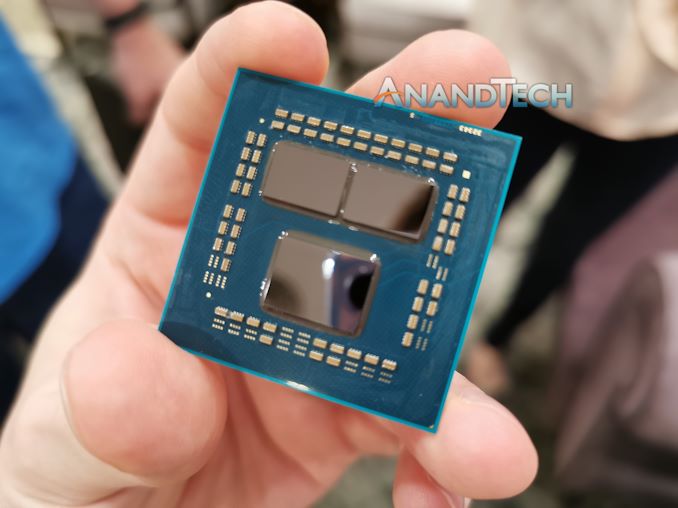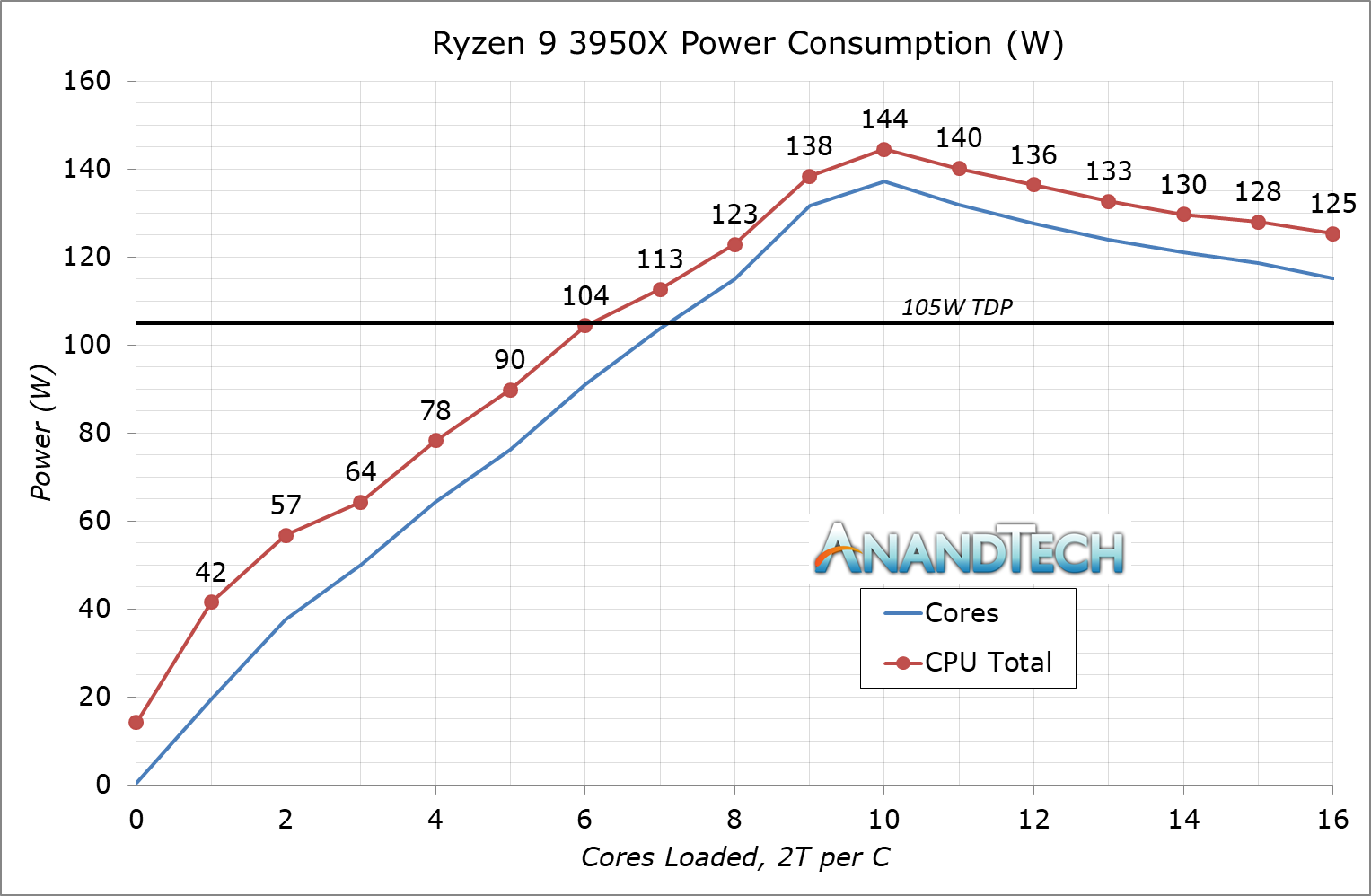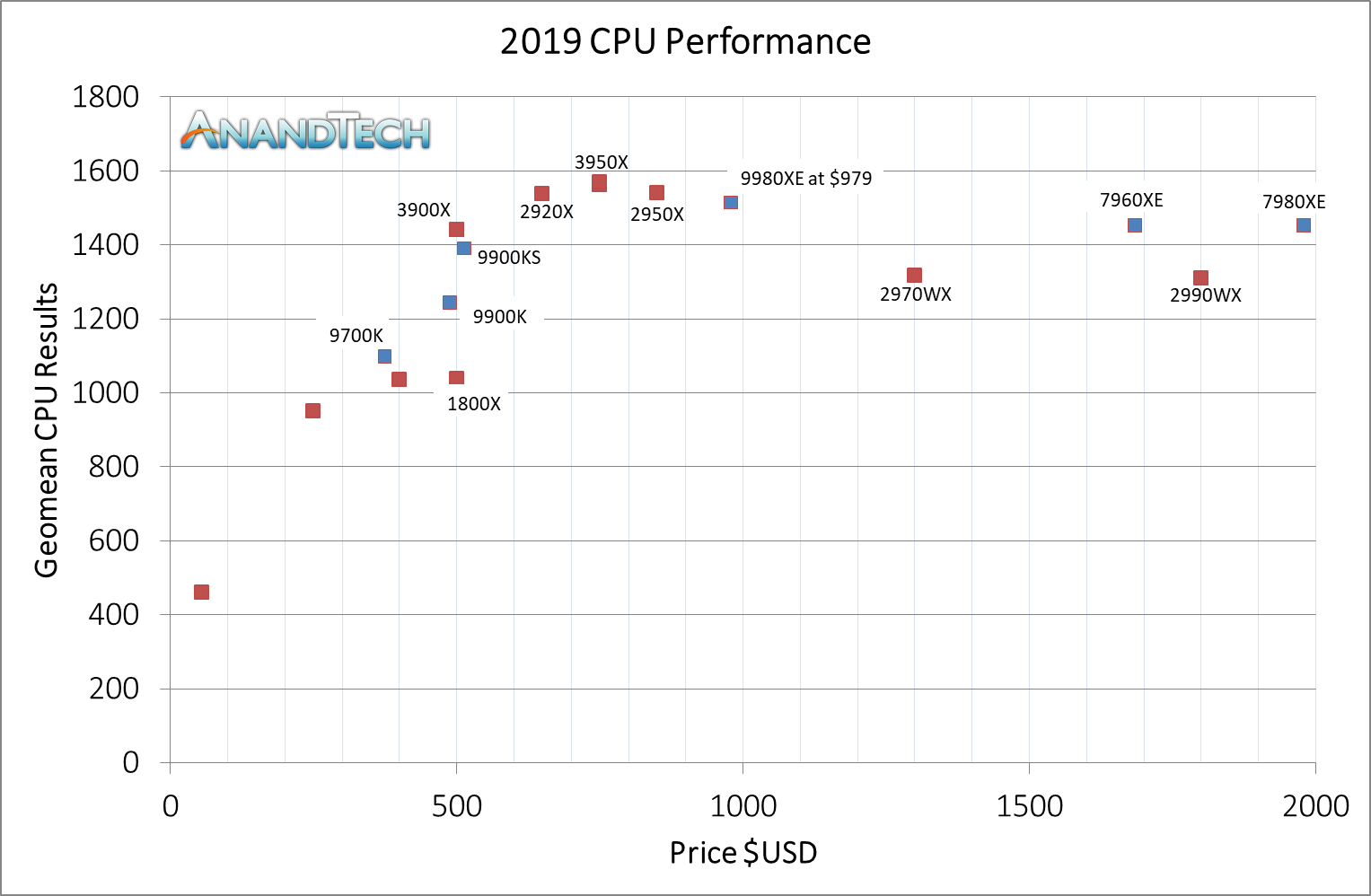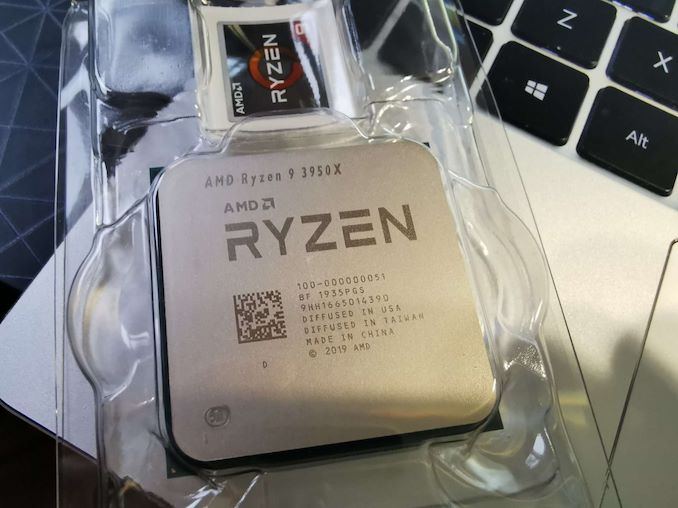The AMD Ryzen 9 3950X Review: 16 Cores on 7nm with PCIe 4.0
by Dr. Ian Cutress on November 14, 2019 9:00 AM ESTConclusion
There are many attributes by which a processor is examined. Absolute performance is the one that grabs the headlines – either by way of single core performance, or the chip performance as a whole, most often applied to an arbitrary benchmark. Aside from raw by-the-numbers performance, we also look at popular workloads, where the CPU plays a critical role. Gaming, on the other hand, is where the CPU is still important but often secondary, and so we end up analyzing the relationship between the CPU and the GPU. Beyond performance, we have cost to consider, and if a product is priced appropriately for the market it aims for.
For performance, perhaps the obvious that was expected was observed: AMD’s 3950X knocks down walls that only a couple of years ago seemed impenetrable. When compared to its immediate rivals, The Ryzen 9 3950X smashes through several of our tests published here, such as the Photoscan, Blender, Handbrake, and 7-zip, while CineBench R20 and SPEC in our benchmark database also have some strong numbers.
Because it is competing against Intel’s high-end Skylake Refresh desktop platform (comparing equal core count, rather than price), it can’t compete when AVX-512 is in play, or memory bandwidth is the limiting factor. At some level having this many cores requires extra memory bandwidth, and dual channel isn’t going to cut it. This is one of the downsides of moving ‘mainstream’ up to a HEDT price point, even if it does come with more cores.
There are some other minor points to note – if we compare single threaded performance, despite AMD’s Zen 2 having a general IPC advantage, the Core i9-9900KS is still running at 5.0 GHz for sustained single threaded work, which is still 7-15% higher than the Ryzen 3950X, and as a result it does pull out ahead in a number of ST tests as well as in low resolution (CPU-bound) gaming. At higher resolution gaming, most of the CPUs in our test perform within a fraction of each other.
We did test the Ryzen 9 3950X with both the normal Windows 'High Performance' (HP) power plan, and the 'Ryzen High Performance' (RHP) power plan that comes with the chipset drivers. Overall the RHP showed higher frequencies and 2-3% more performance than the HP, for about +4W on peak power consumption. Now we're in a quandry as to continue with the RHP - it's technically not out of the box performance, however we still have to install chipset drivers with every test, and the RHP is part of the package. We recommend users use the RHP either way, however it would be helpful if Microsoft recognized a Ryzen 3000 series processor and automatically offered / enabled the RHP in the power settings.
Another key point in our testing was power. Using our power consumption test that outputs the processor's internal power metrics, we saw a considerable inflection in overall CPU power consumption when more than 10 cores were loaded. At this level, the two chiplets are over half occupied, so the desire to balance power over cores and reduce frequency occurs. Normally we expect the power to equalize at that peak level across all the cores, however something else is happening on the chip that means a lower overall power level is found. This is perhaps current density on the Zen 2 cores and chiplets becoming a factor, although we are talking about moving from 10W per core to 12W per core, which isn't a considerable jump, but might just be enough of a voltage jump to become a concern at some level. We technically saw this on the Ryzen 9 3900X as well, with the 10-core power consumption being a few watts higher than the 12-core result. But as that chip only has 12 cores, it wasn't much of a concern.
The Ryzen 3000 family also marks a turning point regarding AMD's use of official TDP ratings. We're seeing power consumption values higher than the TDP on the box, equal to AMD's PPT rating. Before with Ryzen 1000 and Ryzen 2000 there was some good parity between TDP and power consumption, but now there is not. Note, this isn't as bad as the difference between Intel's TDP-on-the-box and the actual power consumption of its turbo modes, and likely AMD is seeing this market expoitation of TDP vs Turbo as a potential avenue for performance. Ideally we should be getting several numbers on the box explaining this (TDP and PPT), but as of yet I've not seen any desire to do so. As we move into 280W 3rd Gen Threadripper processors, we'll be inspecting those to see if it changes for those as well.
The High-Level Holistic View: Ryzen Wins
In order to put all of our data into a conclusion that was more meaningful, we took the geometric mean of a cross section of our benchmarks. For the cross section of benchmarks, we covered a range of ST and MT tests, and we plotted a number of chips as a function of price.
A geometric mean (or average) is different to a standard average: e.g. if two benchmarks score 100 and 500 on one chip, but 250 and 350 on the other, it gives the same standard average. But, looking at the data, the second test is 33% lower but the first test is 2.5x higher. Ultimately the second chip might overall be better: both chips are equal in a standard average, but the geometric mean recognizes that 2.5x difference vs only a 33% drop and adjusts the value accordingly.
We get this graph:
In terms of absolute performance across our benchmark range, the Ryzen 9 3950X has the lead. This metric also puts the 3900X above the 9900KS, because despite the 5.0 GHz all-core on 8-cores, moving to 12-core and 16-core at almost the same performance per core gives more of an advantage in our test suite's MT-heavy workloads. As we move to the more expensive HEDT chips, the 16-core and 18-core from Intel, then even with strong AVX-512 performance, it’s not enough to offset other areas.
For users who want the best without going to the high-end desktop, the Ryzen 9 3950X has the best overall score out of all the chips we’ve ever tested.
If you thought the 3900X didn't have enough power, the 3950X is your answer.
Looking forward, we’re going to have an interesting time with the upcoming HEDT chips from both companies, as users who need HEDT will need something more than what the AM4 has to offer. AMD is set to launch its 3rd Generation Threadripper platform on the 25th, and Intel's Cascade Lake-X CPUs are also due out later this month. Stay tuned for those reviews.















206 Comments
View All Comments
Spunjji - Thursday, November 14, 2019 - link
In theory it might be. In practice, they're still only able to make mobile CPUs with 4 cores or less on it.Orange_Swan - Thursday, November 14, 2019 - link
Nah, they've got at least one 6core/12thread, 15/25w mobile CPU, the Core i7-10710URetycint - Thursday, November 14, 2019 - link
That's 14nm. All Intel's 10nm processors so far have been limited to 4 core Ice Lake U processorsSmartcom5 - Friday, November 15, 2019 - link
If, and that's the whole issue here since a while now, IF Intel's 10nm would be working after all.Sure enough, that's a requirement which still needs to be fulfilled yet. The best process – no matter how oh so advanced it is going to be (on paper) – is worth exactly no·thing if it ain't working. Then, even a (on paper inferior) node is superior, since it at least meets a crucial condition; It's working (already).Thus, it isn't anymore. They relaxed it quite a bit in 2017 to make it work, that's it.
Intel's actual 10nm which spawned Ice Lake isn't the same as it was before, that's why it's coined 10nm+. It's actually less dense than Intel's initial and original-10nm which brought Cannonlake – density was toned down, it's more like ~12nm now.
Interestingly TSMC on its current 7nm N7-process already archives virtually the very same density Intel failed to archive on their initial 10nm-process back then – while their current 10nm+, which has a toned-down density from initially 2.7× down to only some 2.0—2.2× (depending on what sources you're willing to trust), is rumoured to rather equal some 12nm-ish alike process instead of being closer to any initial Intel'ian 10nm.
So while Intel somehow failed, others archived the same density-goals Intel was trying to do for years, to no greater avail – and those others where even on track as scheduled most of the time. Thus, TSMC already fabs on a process which would equal Intel's very initial 10nm-process, which never really saw any greater light of day, bar that known i3-8121U (well, and that m3-8114Y of course, ... you don't know a thing about it, okay?).
GraveNoX - Thursday, November 14, 2019 - link
Yes, they will launch 10nm and 7nm on the same day so you have the freedom to choose which version of the chip you want.Oliseo - Thursday, November 14, 2019 - link
"Based on my imagination Intel will destroy AMD"Santoval - Thursday, November 14, 2019 - link
It is meaningless to compare Intel's 7nm parts, which will be released in 2021 assuming NO delays (thus more realistically in 2022+) with AMD's current 7nm parts. If you were going for a "node for node" comparison that is even more meaningless, because Intel's 7nm node will be equivalent to TSMC's 4nm or 5nm node in transistor density (I have read numbers predicting ~185 million transistors per mm^2 for TSMC's 5nm node and ~200nm MTr/mm^2 for Intel's 7nm node). TSMC's 5nm node will almost certainly be released before Intel's 7nm node by the way.Regarding Intel's 10nm node parts, while Sunny Cove appears to have a higher IPC than Zen 2 Intel's 10nm parts suffer from much lower clocks which have eaten away all or almost all the IPC gains. This is why Intel have not announced an Ice Lake-S/H release and intend to replace it with Comet Lake-S/H. S/H parts require high clocks, which cannot be provided by Intel's 10nm+ node due to very low yields at high clocks. Only low power Ice Lake-U/Y parts and Ice Lake Xeons will be released. Why? Because these parts have lower clocks.
More or less the same thing might be repeated with Tiger Lake, in 2H 2020, which would mean that Intel are not very confident of fixing their 10nm node issues even with their 10nm++ node variant. It is rumored that there will be no Tiger Lake-S/H parts and Rocket Lake-S/H will take their place. What's Rocket Lake? A 14nm+++++++ part but with a new μarch (Sunny or Willow Cove cores and a Gen11 or Gen12 iGPU).
Santoval - Thursday, November 14, 2019 - link
edit : "and ~200 MTr/mm^2 for Intel's 7nm node".Targon - Thursday, November 14, 2019 - link
Didn't TSMC start 5nm risk production a month or so ago?John_M - Monday, November 25, 2019 - link
Yes, they did.